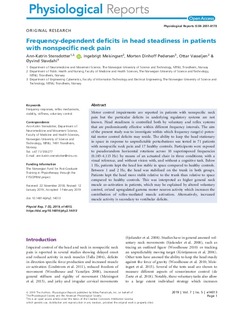| dc.contributor.author | Stensdotter, Ann-Katrin | |
| dc.contributor.author | Meisingset, Ingebrigt | |
| dc.contributor.author | Pedersen, Morten Dinhoff | |
| dc.contributor.author | Vasseljen, Ottar | |
| dc.contributor.author | Stavdahl, Øyvind | |
| dc.date.accessioned | 2019-03-29T07:59:32Z | |
| dc.date.available | 2019-03-29T07:59:32Z | |
| dc.date.created | 2019-03-05T18:59:01Z | |
| dc.date.issued | 2019 | |
| dc.identifier.citation | Physiological Reports. 2019, 5 (7), 1-11. | nb_NO |
| dc.identifier.issn | 2051-817X | |
| dc.identifier.uri | http://hdl.handle.net/11250/2592315 | |
| dc.description.abstract | Motor control impairments are reported in patients with nonspecific neck pain but the particular deficits in underlying regulatory systems are not known. Head steadiness is controlled both by voluntary and reflex systems that are predominantly effective within different frequency intervals. The aim of the present study was to investigate within which frequency range(s) potential motor control deficits may reside. The ability to keep the head stationary in space in response to unpredictable perturbations was tested in 71 patients with nonspecific neck pain and 17 healthy controls. Participants were exposed to pseudorandom horizontal rotations across 10 superimposed frequencies (0.185–4.115 Hz) by means of an actuated chair in three conditions; with a visual reference, and without vision with, and without a cognitive task. Below 1 Hz, patients kept the head less stable in space compared to healthy controls. Between 1 and 2 Hz, the head was stabilized on the trunk in both groups. Patients kept the head more stable relative to the trunk than relative to space compared to healthy controls. This was interpreted as higher general neck muscle co‐activation in patients, which may be explained by altered voluntary control, or/and upregulated gamma motor neuron activity which increases the contribution of reflex‐mediated muscle activation. Alternatively, increased muscle activity is secondary to vestibular deficits. | nb_NO |
| dc.language.iso | eng | nb_NO |
| dc.publisher | Wiley Open Access | nb_NO |
| dc.rights | Navngivelse 4.0 Internasjonal | * |
| dc.rights.uri | http://creativecommons.org/licenses/by/4.0/deed.no | * |
| dc.title | Frequency-dependent deficits in head steadiness in patients with nonspecific neck pain | nb_NO |
| dc.type | Journal article | nb_NO |
| dc.type | Peer reviewed | nb_NO |
| dc.description.version | publishedVersion | nb_NO |
| dc.source.pagenumber | 1-11 | nb_NO |
| dc.source.volume | 5 | nb_NO |
| dc.source.journal | Physiological Reports | nb_NO |
| dc.source.issue | 7 | nb_NO |
| dc.identifier.doi | https://doi.org/10.14814/phy2.14013 | |
| dc.identifier.cristin | 1682498 | |
| dc.description.localcode | (C) 2019 The Authors. Physiological Reports published by Wiley Periodicals, Inc. on behalf of The Physiological Society and the American Physiological Society. This is an open access article under the terms of the Creative Commons Attribution License,which permits use, distribution and reproduction in any medium, provided the original work is properly cited. | nb_NO |
| cristin.unitcode | 194,65,30,0 | |
| cristin.unitcode | 194,65,20,0 | |
| cristin.unitcode | 194,63,25,0 | |
| cristin.unitname | Institutt for nevromedisin og bevegelsesvitenskap | |
| cristin.unitname | Institutt for samfunnsmedisin og sykepleie | |
| cristin.unitname | Institutt for teknisk kybernetikk | |
| cristin.ispublished | true | |
| cristin.fulltext | postprint | |
| cristin.qualitycode | 1 | |

